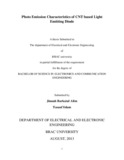| dc.contributor.advisor | Mominuzzaman, Sharif Mohammad | |
| dc.contributor.author | Alim, Jinnah Barkatul | |
| dc.contributor.author | Islam, Tasauf | |
| dc.date.accessioned | 2014-02-13T07:34:55Z | |
| dc.date.available | 2014-02-13T07:34:55Z | |
| dc.date.copyright | 2013 | |
| dc.date.issued | 2013-08 | |
| dc.identifier.other | ID 09310007 | |
| dc.identifier.other | ID 09110045 | |
| dc.identifier.uri | http://hdl.handle.net/10361/2934 | |
| dc.description | This thesis report is submitted in partial fulfillment of the requirements for the degree of Bachelor of Science in Electrical and Electronic Engineering, 2013. | en_US |
| dc.description | Cataloged from PDF version of thesis report. | |
| dc.description | Includes bibliographical references (page 71). | |
| dc.description.abstract | At present time, different types of LEDs are available in the market. Currently, most widely used semiconducting material to make LEDs is silicon (Si). But there are some problems associated with Si. The major & main problem is, Si is an indirect bandgap material. That‘s why; electrons cannot easily move to valence band from conduction band. That is why, in this thesis we have worked to find out a possible alternative and that is carbon nanotube (CNT). The major advantage of CNT is, here we can control the peak emission. That‘s why; at first we have worked with unipolar & ambipolar emission and observed a huge difference in intensity. First of all, we have fitted the unipolar EL spectrum curve & obtained six major peaks. On the other hand, after fitting the ambipolar EL spectrum curve we have obtained three major peaks. The peak intensity of unipolar emission was 4.61 (arb units). On the other hand, the peak intensity of ambipolar emission was 28.2 (arb units). After that, for bipolar emission we have analyzed the EL spectrum of CNT based LED for different drain-source current IDS. Applying the fitting technique on each curve, we have obtained few peaks. After obtaining the fitted curves, we have plotted curves for different position, intensity & FWHM of peak1 & peak2, corresponding the drain-source current IDS. Then we have observed that the position of peak1 does not remains constant. With increasing IDS, it moves towards the lower energy. Up to IDS=155 nA, it keeps the trend unchanged. After that it starts to move towards the higher energy. But peak2 shows a different trend. Just like peak1 it moves towards the lower energy up to IDS=155 nA. But after that, it becomes stable. When we observed the intensity of peak1, corresponding the drain-source current IDS, we have seen that the intensity of peak1 increases with increasing IDS. But when IDS reaches to 155 nA, it starts to decrease. For peak2, intensity also increases with IDS but it does not decrease. After that we have observed the FWHM of peak1. The FWHM of peak1 decreases with increasing IDS. But when IDS reaches to 120 nA, it starts to decrease drastically. And when IDS reaches to 180 nA it starts to increase. But for peak2, we have observed a different scenario. The FWHM of peak2 almost remains constant up to 120 nA. After that it starts to increase. And when IDS reaches to 155 nA, it decreases drastically. And when IDS approaches to 180 nA it drastically increases. We have also plotted the ratio of intensity of peak2 & peak1, corresponding the drain-source current IDS. We have observed that the ratio of intensity increases with IDS. And when IDS reaches to 12 155 nA, it increases rapidly. After that, we have plotted the ratio of area of peak2 & peak1, corresponding the drain-source current IDS. Here we have seen that the ratio of area increases rapidly with IDS. And when IDS reaches to 120 nA, it rapidly decreases. Again when IDS approaches to 155 nA it starts to increase. In this thesis we have worked with two peaks only. But, in the fitted curves there are some other peaks too which could be a mean for further research. | en_US |
| dc.description.statementofresponsibility | Jinnah Barkatul Alim | |
| dc.description.statementofresponsibility | Tasauf Islam | |
| dc.format.extent | 71 pages | |
| dc.language.iso | en | en_US |
| dc.publisher | BRAC University | en_US |
| dc.rights | BRAC University thesis are protected by copyright. They may be viewed from this source for any purpose, but reproduction or distribution in any format is prohibited without written permission. | |
| dc.subject | Electrical and electronic engineering | |
| dc.title | Photo emission characteristics of CNT based light emitting diode | en_US |
| dc.type | Thesis | en_US |
| dc.contributor.department | Department of Electrical and Electronic Engineering, BRAC University | |
| dc.description.degree | B. Electrical and Electronic Engineering | |

